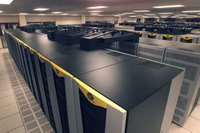 NASA used a supercomputer to simulate the collision of two black holes. The space agency is hoping it will be able to validate Einstein’s general relativity theory in the process. The task of simulating the merger of black holes fell to Columbia, the fourth fastest supercomputer in the world. Built by SGI, Columbia can reach the speed of 51.87 trillion floating-point operations per second.
NASA used a supercomputer to simulate the collision of two black holes. The space agency is hoping it will be able to validate Einstein’s general relativity theory in the process. The task of simulating the merger of black holes fell to Columbia, the fourth fastest supercomputer in the world. Built by SGI, Columbia can reach the speed of 51.87 trillion floating-point operations per second. The simulation is so far the largest astrophysical calculation performed on a NASA supercomputer, and it took Columbia’s 2,032 Intel Itanium 2 processors 80 hours to complete it.
The simulation is so far the largest astrophysical calculation performed on a NASA supercomputer, and it took Columbia’s 2,032 Intel Itanium 2 processors 80 hours to complete it.Before NASA was able to run the simulation, it needed to translate Einstein’s theory, which uses tensor calculus, into something that the supercomputer can understand. Einstein has surmised that black hole collisions will produce ripples in space-time, akin to the wobbling of gelatin.
NASA story can be found here
List of Top 500 most powerful supercomputers
Photo credit: Henze, NASA
No comments:
Post a Comment